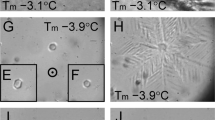Summary
Hemolymph ice nucleating factors are found in many freeze tolerant insects. These factors function to initiate ice nucleation in the extracellular fluid at fairly high subzero temperatures thereby minimizing the possibility of lethal intracellular ice formation.
An ice nucleating protein was purified from the hymolymph of pupal bald faced hornets,Vespula maculata. This is the first ice nucleating protein to be purified. The protein has a molecular weight of 74,000, as determined by SDS-PAGE, and is quite hydrophilic. Glutamate and/or glutamine accounts for 20% of the amino acid residues. It is likely that the hydrophilic nature of the protein is involved in the ability of the protein to function as an ice nucleator.
Similar content being viewed by others
References
Baust JG (1973) Mechanisms of cryoprotection in freezing tolerant animal systems. Cryobiology 10:197–205
Davis JA (1964) Advances in gel electrophoresis. Ann NY Acad Sci 121:404–427
Dubois M, Giles KA, Hamilton JK, Rebers PA, Smith F (1956) Colorimetric method for determination of sugars and related substances. Anal Chem 28:350–356
Duman JG, Horwath KL (1983) The role of hemolymph proteins in the cold tolerance of insects. Annu Rev Physiol 45:261–270
Duman JG, Patterson JL (1978) The role of ice nucleators in the frost tolerance of overwintering queens of the bald faced hornet. Comp Biochem Physiol 59A:69–72
Fairbanks G, Steck TL, Wallach DFH (1971) Electrophoretic analysis of the major polypeptides of the human erythrocyte membrane. Biochem 10:2606–2617
Farrant J (1980) General observations, on cell preservation. In: Ashwood-Smith MJ, Farrant J (eds) Low temperature preservation in medicine and biology. University Park Press, Baltimore, pp 1–18
Knight CA (1967) The freezing of supercooled liquids. Van Nostrand Co. Inc. Princeton, NJ, pp 8–48
Knight CA (1979) Ice nucleation in the atmosphere. Adv Coll Int Sci 10:369–395
Kuntz ID, Kauzmann W (1974) Hydration of proteins and polypeptides. Adv Prot Chem 28:239–345
Miller K (1982) Cold-hardiness strategies of some adult and immature insects overwinteringin interior Alaska. Comp Biochem Physiol 73A:595–604
Moore S, Stein WH (1963) Amino acid analysis. In: Colowick CP, Kaplan NO (eds) Methods in enzymology, vol VI. Academic Press, New York, pp 107–156
Rees RA (1946) The estimation of theonine and serine in proteins. Biochem J 40:632–635
Ring RA (1982) Freezing-tolerant insects with low supercooling points. Comp Biochem Physiol 73A:605–612
Sömme L (1978) Nucleating agents in the hemolymph of third instar larvae ofEurosta solidagensis (Fitch) (Dept., Tephritidae). Norw J Ent 25:187–188
Weber K, Osborn M (1969) The reliability of molecular weight determinations by dodecyl sulfate gel electrophoresis. J Biol Chem 244:4406–4412
Zachariassen KE, Hammel HT (1976) Nucleating agents in the hemolymph of insects tolerant to freezing. Nature 262:285–287
Author information
Authors and Affiliations
Rights and permissions
About this article
Cite this article
Duman, J.G., Morris, J.P. & Castellino, F.J. Purification and composition of an ice nucleating protein from queens of the hornet,Vespula maculata . J Comp Physiol B 154, 79–83 (1984). https://doi.org/10.1007/BF00683219
Accepted:
Issue Date:
DOI: https://doi.org/10.1007/BF00683219




